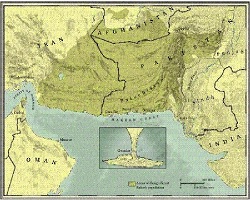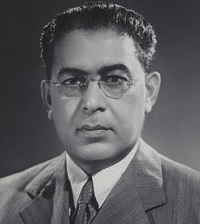 |
 |
 |
 |
 |
 |
Opinion Piece on
Gwadar in Historical Perspective
by Rafaqat Hussain, Research Associate, MUSLIM Institute
|
|
|
Gwadar is situated in Baluchistan (province of Pakistan) at the very entrance leading to the Persian Gulf, located at the apex of Indian Ocean on an important sea trade route. It is a hammer head peninsula on the western part of Makran. This peninsula has two almost perfect, but naturally curved, semicircular bays on either side, namely the Paddi Zirr (West Bay) and Deymi Zirr (East Bay). Gwadar city is located 472 KM west of Karachi, 80 KM east of the Iranian border and about 320 KM north east of Cape al-Hadd in Oman, and situated in close proximity to the Iranian ports of Chahbahar and Bander Abbas. Gwadar is located at the point of inter junction of three economically powerful regions of the world, Middle East, Central Asia and South Asia. So this geographical location imparts it very important strategic location.
Gwadar in the Balochi language means Gateway of Winds. The Makran region surrounding Gwadar was occupied by unknown Bronze Age people who settled in the few oases. It later became the Gedrosia region of the Achaemenid Persian Empire. The region is believed to have been conquered by the founder of the Persian Empire, Cyrus the Great. According to the historians, in 325 B.C during the homeward march of Alexander the Great, his admiral Nearchus led a fleet along the modern Makran coast and recorded that the area was dry and mountainous inhabited by the Ichthyophagoi or Fish eater a Greek word rendering of the ancient Persian phrase Mahikhoran, which has become the modern word Makran 1. After the collapse of Alexander’s empire, the area was ruled by Seleucus Nicator, one of Alexander’s generals, but ceded to the Maurya dynasty in 303 BC.
In 644 A.D from Persia the conquering Muslim forces under the command of Hakim bin Amr al Taghlabi crossed over into Makran district of Baluchistan and conquered the area. Hazrat Umar (R.A) (second caliph of the Rashidun Caliphate) instructed Hakim bin Amr al Taghlabi that for the time being Makran should be the easternmost frontier of the Muslim dominions, and that no further attempt should be made to extend the conquest 2. In 711 A.D Muslim army under Muhammad bin Qasim captured the town of Gwadar. In the following centuries the area was contested between various Iranian and Indian based powers including the Mughals and the Safavids. Portuguese explorers captured and ransacked Gwadar in the late 16th century. This was followed by centuries of local rule by various Baloch tribes.
In 1783 sultan of Muscat Sultan Bin Ahmed fell out with his brother Saad Bin Ahmed. And Sultan Bin Ahmed entered into communication with Khan of Qalat and showed his interest to come here. Nasir Khan I, of the Ahmadzai family of the Brahui ethnic group of Kalat "granted" the port of Gwadar to Sultan Bin Ahmad of the Al Bu Sa'id tribe of Oman, who escaped from Muscat around 1784. Sultan Bin Ahmad maintained this possession also after his accession to the throne of Muscat. One of the first steps taken by Sultan Bin Ahmad was the nomination of a Wali, an Arab deputy at Gwadar, who received the order to build a fort in the best safeguarded side of Gwadar Bay.
After the first Afghan war this area came to the attention of British. And the British Government after extracting the concessions from Sa’id Sultan for the use of Gwadar port facilitated Muscat to retain Gwadar. Major Goldsmith visited the area in 1861 and an Assistant Political Agent was appointed in Gwadar in 1863 by the British government 3. Omani enclave of Gwadar remained the territory of Oman during the British rule.
Both Pasni and Gwadar have been ports of call (a port used to load/unload cargo or passengers or to take on supplies) for the steamers of the British India Steam Navigation Company. The first ever telegraphic-link to this area was made in 1863 when Gwadar was linked to Karachi.
Telegraph offices were opened at Gwadar and Pasni. Later post offices were opened at Gwadar in 1894 and at Pasni in 1903 by the British government.
In 1947 after the independence of Pakistan, areas except Gwadar and its surroundings joined the Baluchistan States Union, as part of Makran state. Chieftains of Makran, Lasbela, and Kharan acceded to Pakistan. Few months later Khan of Kalat also acceded to Pakistan keeping in view the aspirations of the people of Kalat and ground realities (Kalat was landlocked) but the Gwadar was not under the dominion of Khan of Kalat. The residents of Gwadar started raising their voice to join Pakistan. In 1954 Pakistan government conducted a geological survey of the Gwadar with the help of United States Geological Survey.

|
The surveyor of USGS Worth Condrick introduced Gwadar as a hammer head peninsula and fit for a deep water port. Then in the historical, geographical perspective and according to the aspirations of people of Gwadar, government of Pakistan formally requested the Sultan of Oman and Muscat for granting accession of Gwadar to Pakistan. On 7 September 1958, after four years of negotiations Pakistan purchased the Gwadar enclave from the Sultanate of Muscat and Oman for USD $3 million. Gwadar formally became part of Pakistan on 8 December 1958, after 174 years of Omani rule.
Prime Minister Malik Feroze Khan Noon addressed the nation on Radio Pakistan on 7 September 1958 to break the news of Gwadar's accession to Pakistan; celebrations broke out in Gwadar, Baluchistan and the rest of Pakistan. Part of this radio address is given below:

|
“The Government of Pakistan has issued a communiqué stating that the administration of the Port of Gwadar and its hinterland, which had been in the possession of His Highness the Sultan of Muscat and Oman since 1784, was today taken over by Pakistan with full sovereign rights. The people of Gwadar have joined the people of Pakistan and the whole of Gwadar now forms part of the Islamic Republic of Pakistan. I know that the people all over Pakistan, including those residing in Gwadar, have received this announcement with feelings of great joy. I welcome the residents of Gwadar into the Republic of Pakistan and I would like to assure them that they will enjoy equal rights and privileges along with all other Pakistan nationals irrespective of considerations of religion, caste or creed. They will have their full share in the glory and prosperity of the Republic to which they now belong. The residents of Gwadar, most of who are members of the brave Balochi community, have close racial and cultural links with the people of Pakistan and joining the Republic of Pakistan represents the natural culmination of their political aspirations. I should like to take this opportunity to thank, on behalf of the people and Government of Pakistan, Her Majesty’s Government in the United Kingdom for their assistance and help in bringing to a successful conclusion our negotiations with His Highness the Sultan of Muscat and Oman for the transfer of his rights in Gwadar”4.
In TIME magazine on Monday, Sept. 22, 1958 this communiqué was referred with such a style:
“GWADAR: The Sons of Sindbad
One of the last remaining foreign-flag enclaves on the continent of Asia*was erased last week. In the first international cash-for-territory deal since the U.S. paid $25 million for Denmark's Virgin Islands in 1917, the republic of Pakistan purchased the sun-blanched, 300-sq.-mi. peninsula of Gwadar (pop. 20,000) from the Sultan of Muscat and Oman”.
So with the effect of this treaty Gwadar enclave became the integral part of the sovereign and independent state of Pakistan in conformance with the International law. In 1993 the feasibility study of deep sea port at Gwadar was conducted by Pakistan. In 2005phase one of Gwadar Port project having four berths was completed. In March 2008 first ship anchored at the Gwadar port, bringing 52000 tons of Wheat from Canada. The phase two of the project which is the extension of the port is under construction which has nine additional berths.
Today’s Gwadar is one the rapidly growing city of Pakistan to become an important industrial, trade hub of the country, and strategically important port city of the world. Development of the of Gwadar port will not only raise the living standards of Balochi people but this prosperity will also help to tackle the security issues in Baluchistan. Gwadar also anchors China Pakistan economic corridor (CPEC), which will serve as an important trade route for China, land locked central Asian states and Middle East. It will also help to revive the ancient trade route known as the Silk Road, which started nearly 2400 years ago. Through this trans-regional route, more than 3 billion people of this region could be connected, so development of CPEC and Gwadar, which guarantee regional peace and prosperity, should be completed at the earliest without allowing anyone to attach any controversy to these projects in a bid to impede or delay the same.
|
|
|
|
1.
|
Smith, V. A. (01-Jan-1999). The Early History of India. Atlantic Publishers.
|
|
|
2
|
Translator, G. Rex Smith -The History of al-Tabari. New York: State university of New York, 1994. Vol14.
|
|
|
3
|
Onley, J. (2009). Britain and the Gulf Shaikhdoms, 1820–1971 : Georgetown University School of Foreign Service in Qatar.
“To conduct Britain’s diplomatic relations with the Gulf rulers on a daily basis, the Resident maintained subordinate political agents at Muscat (c.1758–1971) Manama (c.1816–1971), Sharjah (1823–1953), Kuwait (1899–1961), Doha (1949–71), Dubai (1953–71), and Abu Dhabi (1957–71), as well as the Omani enclave of Gwadar in what is now Pakistan (1863–1958)”.
|
|
|
4
|
Gwadar's Accession to Pakistan. (2013).
|
|
|
|
|
 |
 |
 |
 |
 |
 |
|
|